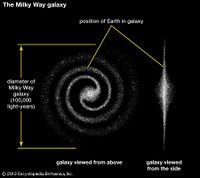|
|
| Line 21: |
Line 21: |
| | <math>=3.452\times10^{41}\text{kg}\approx3\times10^{41}\text{kg}</math> | | <math>=3.452\times10^{41}\text{kg}\approx3\times10^{41}\text{kg}</math> |
| | | | |
| − | # stars
| + | Number of stars |
| | <math>=\frac{M_\text{galaxy}}{M_\text{sun}}=\frac{3.452\times10^{41}\text{kg}}{2\times10^{30}\text{kg}}</math> | | <math>=\frac{M_\text{galaxy}}{M_\text{sun}}=\frac{3.452\times10^{41}\text{kg}}{2\times10^{30}\text{kg}}</math> |
| | <math>=1.726\times10^{11}\approx2\times10^{11}</math> | | <math>=1.726\times10^{11}\approx2\times10^{11}</math> |
Revision as of 09:29, 30 October 2019
Problem
The Sun rotates about the center of the Milky Way Galaxy at a distance of about 30,000 light-years from the center (1 ly =  m). If it takes about 200 million years to make one rotation, estimate the mass of our Galaxy. Assume that the mass distribution of our Galaxy is concentrated mostly in a central uniform sphere. If all the stars had about the mass of our Sun (
m). If it takes about 200 million years to make one rotation, estimate the mass of our Galaxy. Assume that the mass distribution of our Galaxy is concentrated mostly in a central uniform sphere. If all the stars had about the mass of our Sun ( kg), how many stars would there be in our Galaxy?
kg), how many stars would there be in our Galaxy?
Solution
Like the previous question



also

thus
![{\displaystyle M_{\text{galaxy}}={\frac {4\pi ^{2}R^{3}}{GT^{2}}}={\frac {4\pi ^{2}\left(30000\times 9.5\times 10^{35}\right)^{3}{\text{m}}^{3}}{\left(6.67\times 10^{-11}{\text{Nm}}^{2}/{\text{kg}}^{2}\right)\left[\left(200\times 10^{6}{\text{y}}\right)\left(3.14\times 10^{7}{\text{s/y}}\right)\right]^{2}}}}](https://wikimedia.org/api/rest_v1/media/math/render/svg/d4ea3ee858d9e5db0d058da9165f0bdb238e3471)

Number of stars


see Fermi Paradox







![{\displaystyle M_{\text{galaxy}}={\frac {4\pi ^{2}R^{3}}{GT^{2}}}={\frac {4\pi ^{2}\left(30000\times 9.5\times 10^{35}\right)^{3}{\text{m}}^{3}}{\left(6.67\times 10^{-11}{\text{Nm}}^{2}/{\text{kg}}^{2}\right)\left[\left(200\times 10^{6}{\text{y}}\right)\left(3.14\times 10^{7}{\text{s/y}}\right)\right]^{2}}}}](https://wikimedia.org/api/rest_v1/media/math/render/svg/d4ea3ee858d9e5db0d058da9165f0bdb238e3471)


